Dental Costs for Fillings – The Results Are In
If you have a tooth problem, such as cavities, you may want to know – what is the cost for a tooth filling?
The cost of tooth fillings can range anywhere between $115 to $310, depending on the material you choose and what tooth it is.
Today I will talk about the average cost for a Composite Tooth Filling and also discuss what other materials a tooth filling can be made from.
I will provide you with the alternatives for fillings and talk about whether Medicare covers a basic tooth filling.
Lastly, I will also discuss whether private insurance covers fillings, and if so, how many per year.
What Is the Average Cost for a Tooth Filling?
Today, there are several different types of materials available for a tooth filling. Your Dentist will help recommend what type is best for you.
The average cost of the fillings will vary, depending on both the material and your location.
I will discuss these below.
Dental Cost Calculator
Below are the average costs for Composite fillings for front teeth or what Dentists’ refer to as Anterior Teeth.
We have used our Dental Cost Calculator to find these prices for you.
You can search either by treatment, Symptom or by Item code, making it simple to compare the average cost of any dental treatment, Australia wide.
NSW Dental Filling Average Cost - Front Tooth
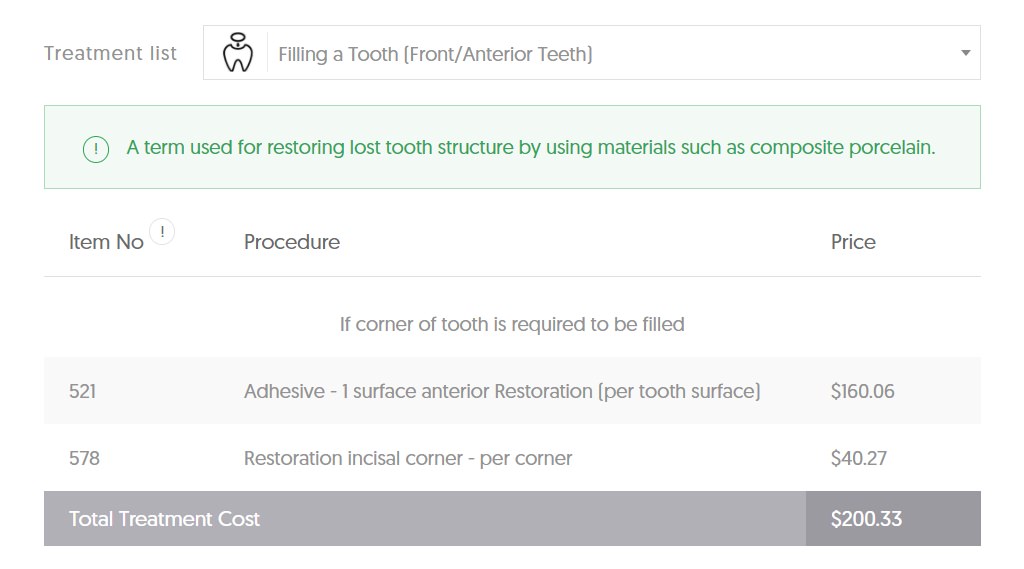
ACT Dental Filling Average Cost - Front Tooth
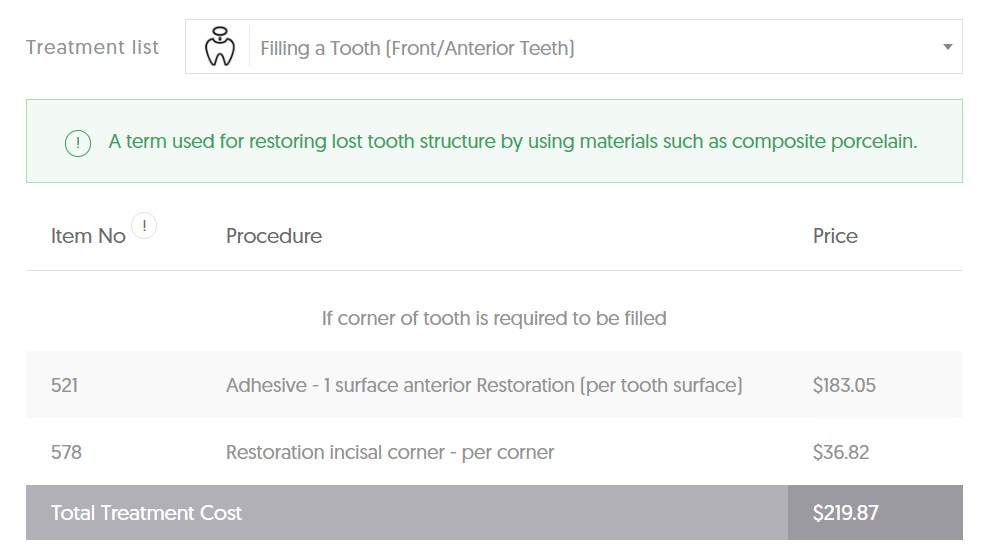
NT Dental Filling Average Cost - Front Tooth
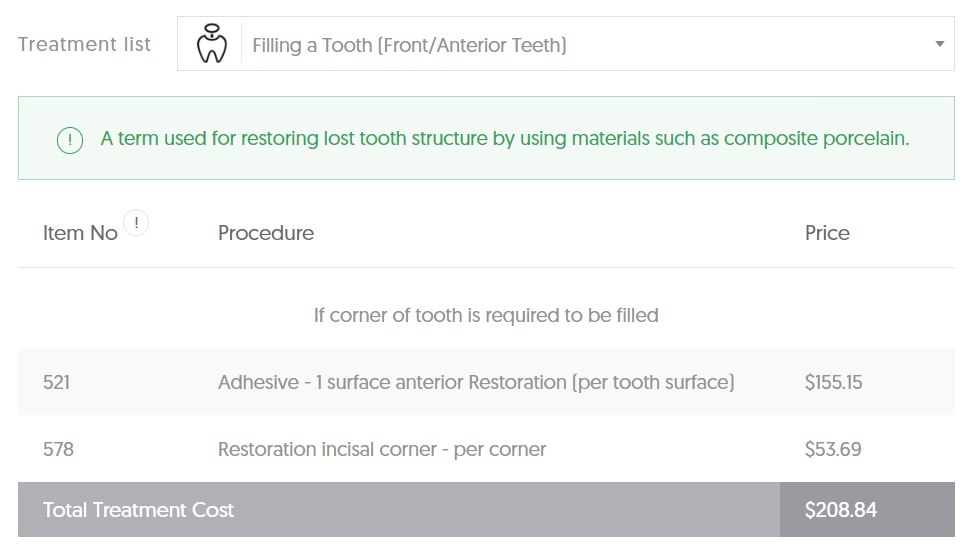
QLD Dental Filling Average Cost - Front Tooth
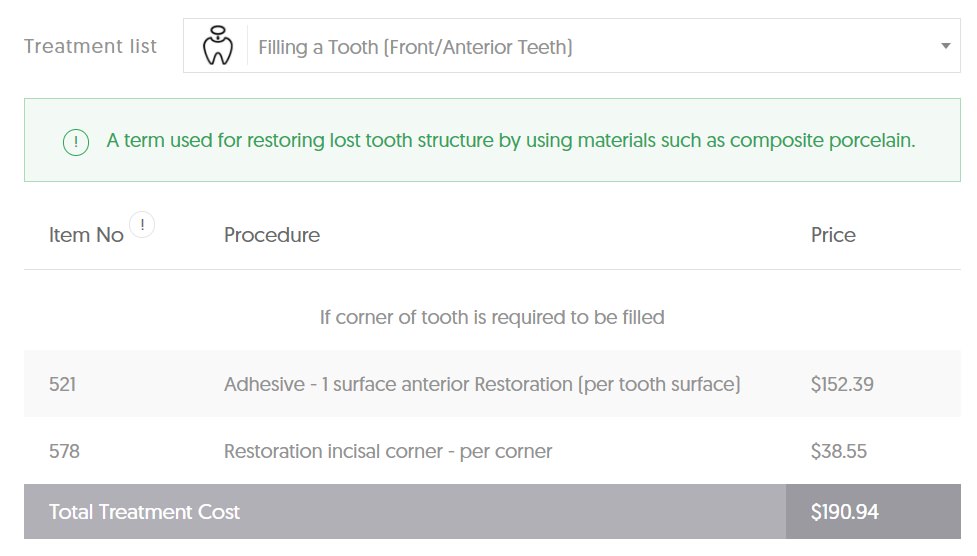
VIC Dental Filling Average Cost - Front Tooth
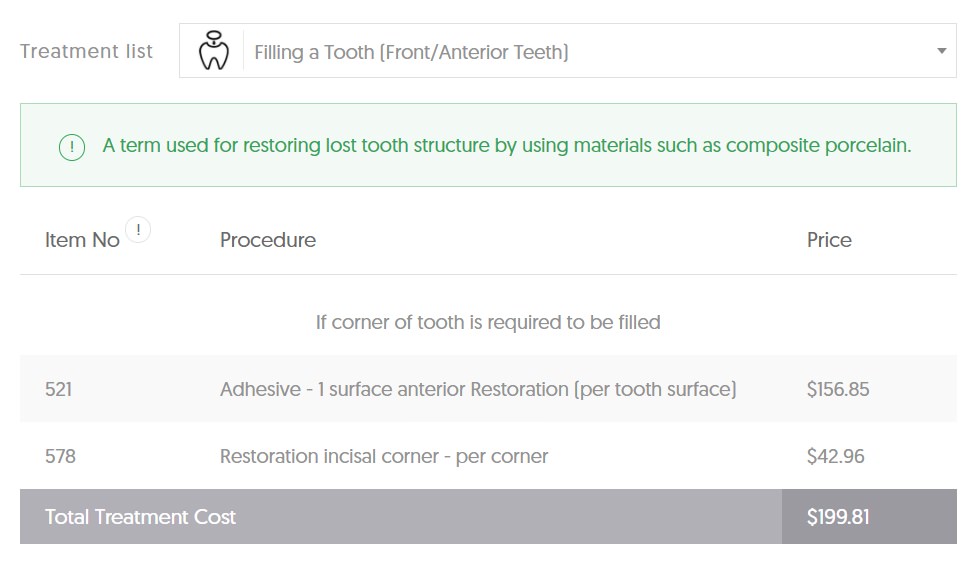
SA Dental Filling Average Cost - Front Tooth
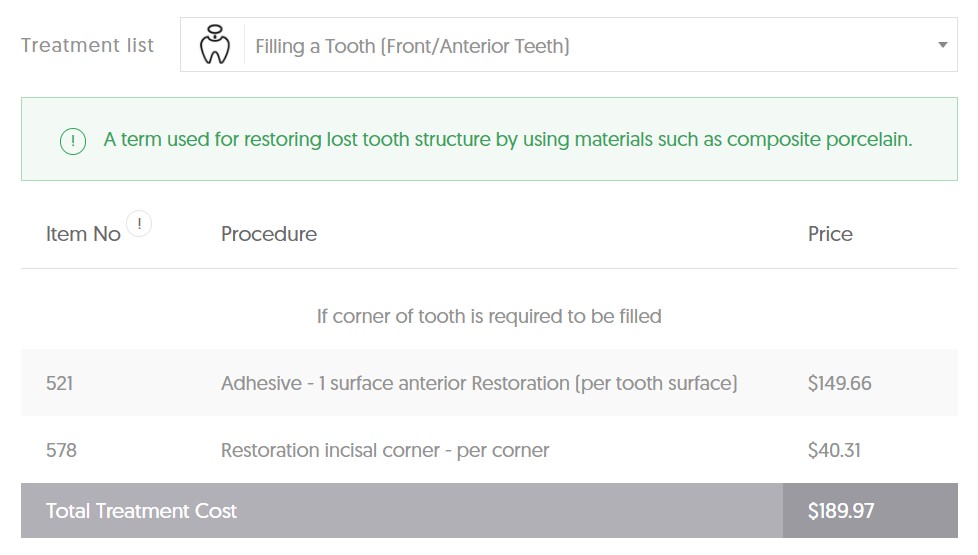
TAS Dental Filling Average Cost - Front Tooth
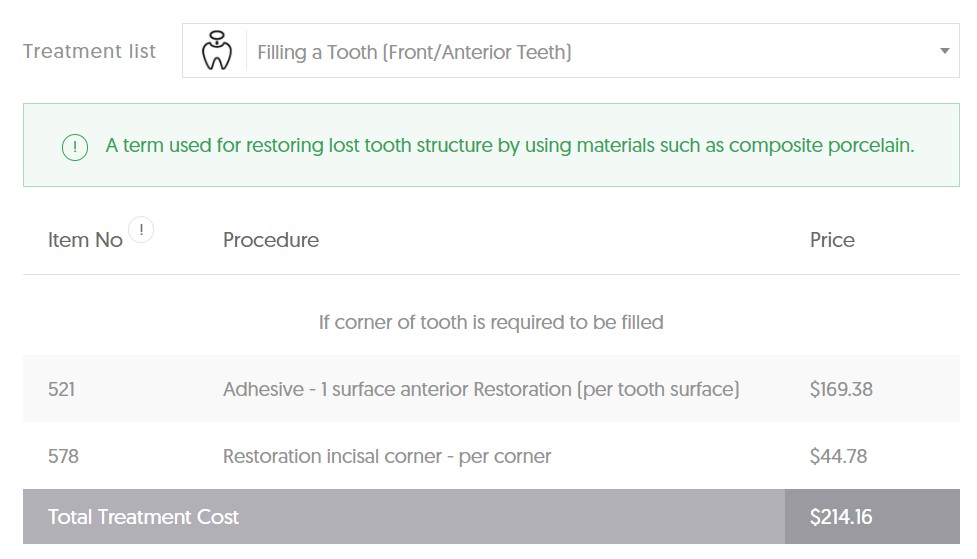
Dental Filling Cost for Back/Posterior Teeth
Next, we’ll look at the cost of a filling for your back teeth or what Dentists’ refer to as Posterior Teeth.
The average price seems to be a touch more expensive than a front tooth, ranging from $197.59 to $243.10
Below is each states average cost for a back tooth dental filling.
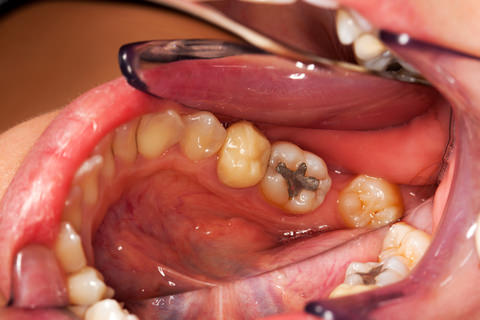
A back tooth filling aka Posterior tooth filling
ACT Dental Filling Average Cost - Back/Posterior Teeth
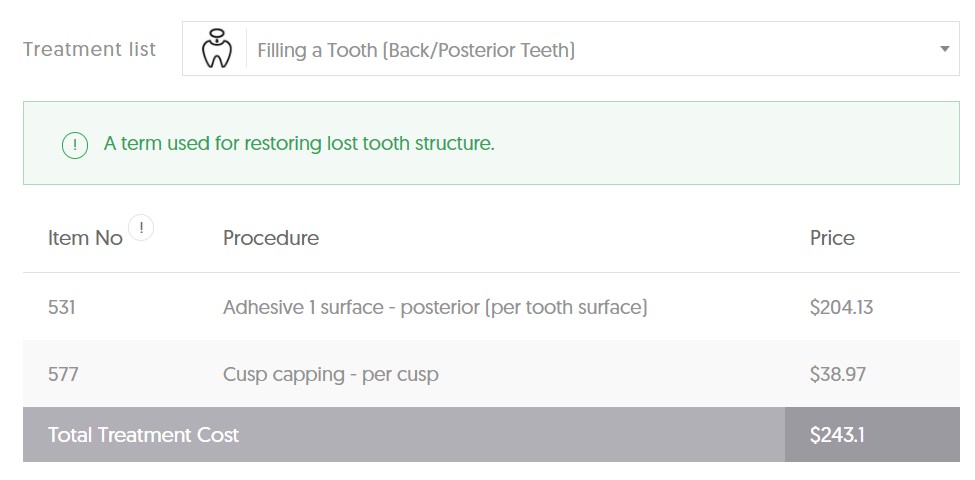
NSW Dental Filling Average Cost - Back/Posterior Teeth
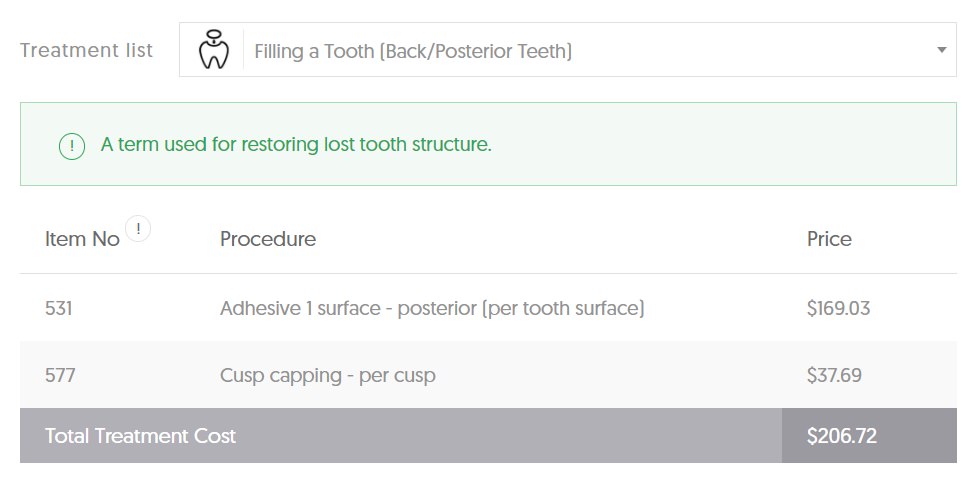
NT Dental Filling Average Cost - Back/Posterior Teeth
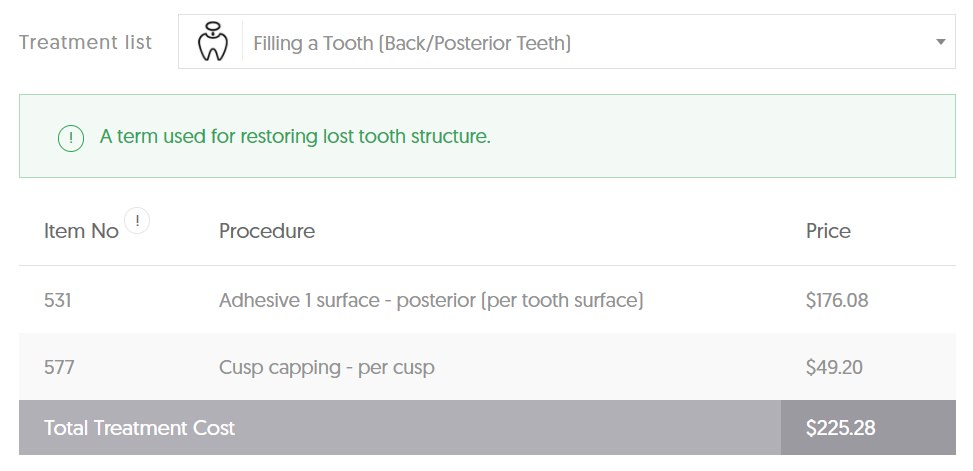
QLD Dental Filling Average Cost - Back/Posterior Teeth
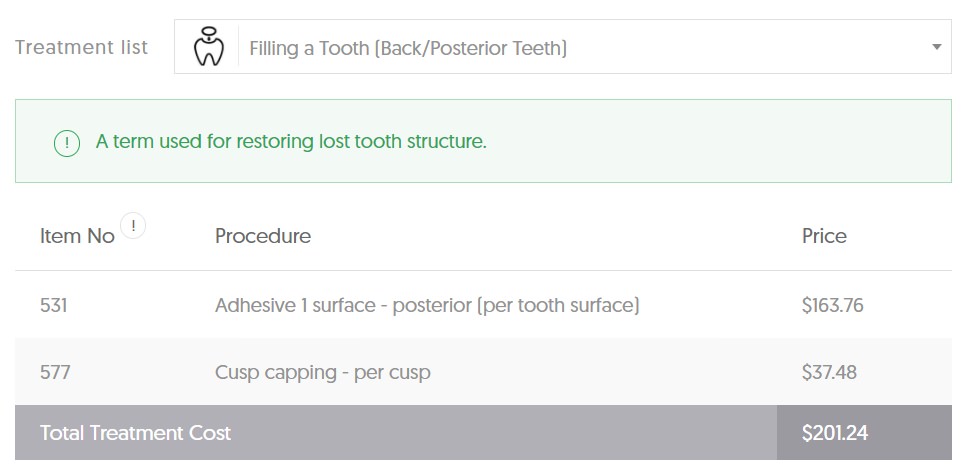
VIC Dental Filling Average Cost - Back/Posterior Teeth
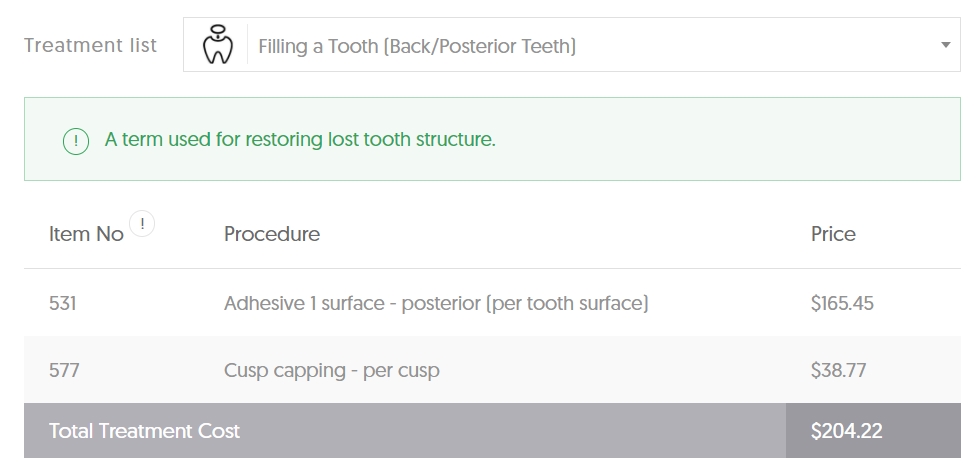
SA Dental Filling Average Cost - Back/Posterior Teeth
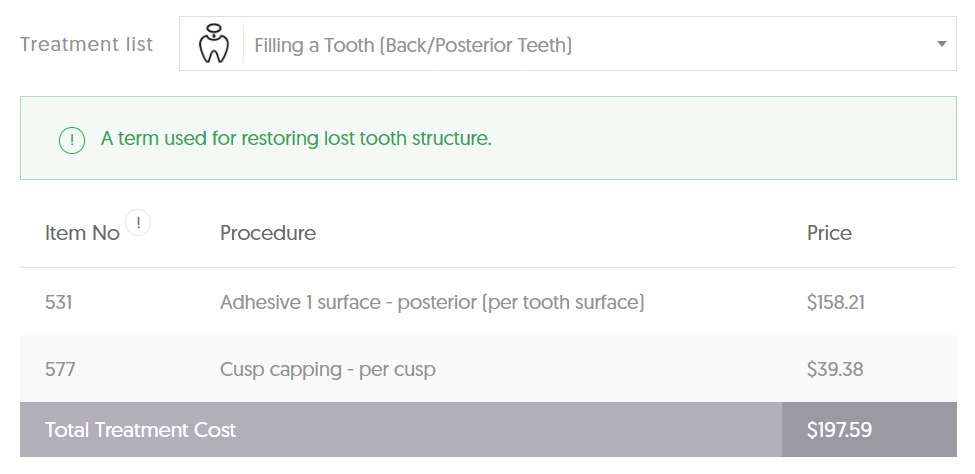
TAS Dental Filling Average Cost - Back/Posterior Teeth
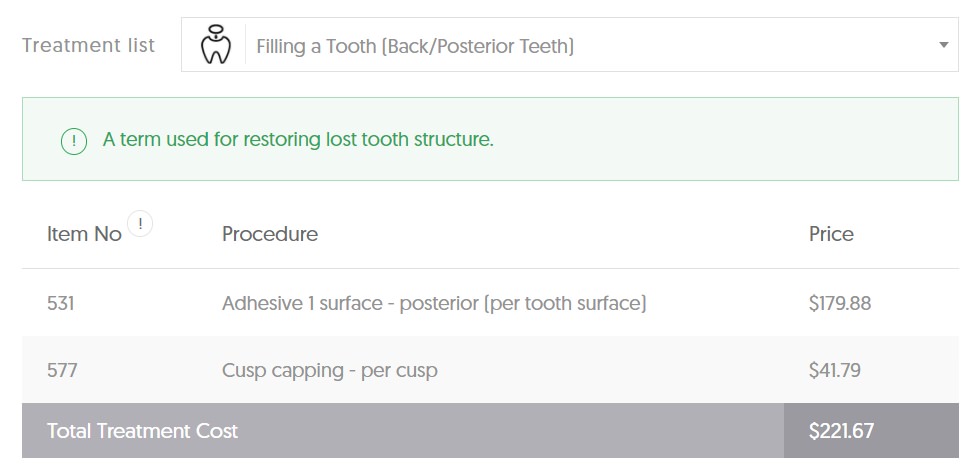
WA Dental Filling Average Cost - Back/Posterior Teeth
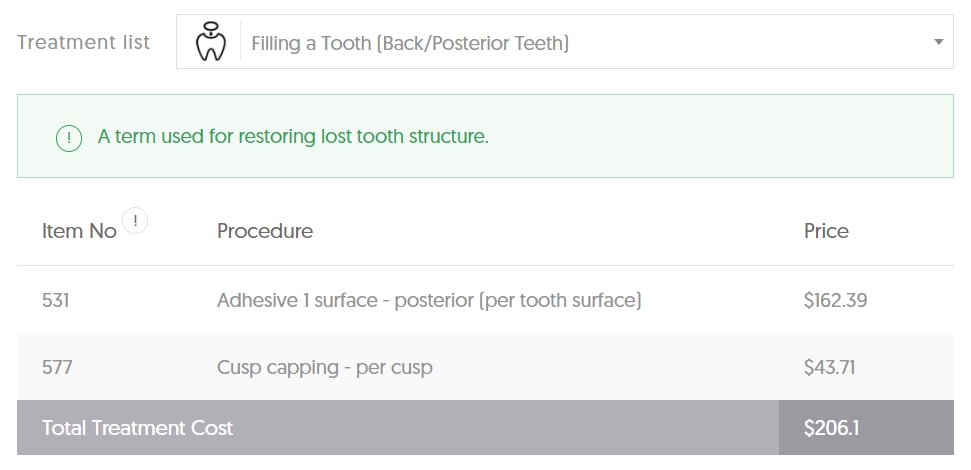
What is “Tooth Filling” Material Made Of
As mentioned, there are more types of materials that a tooth filling can be made from today than ever before, and all have their advantages and disadvantages.
Whilst your Dentist will help you choose the material, knowing the options available will assist you in making the best choice for you and your mouth.
Silver Amalgam
Silver amalgam was a common choice – Dentists’ have been using this for fillings since 1826.
It is made up for a mix of different metals – usually roughly 50% mercury, and tin, copper, silver, or zinc.
The benefits of amalgam are reasonable.
Advantages Include
- Strong.
- Highly resistant, enduring on average 10 – 15 years.
- Easy for the Dentist to put in.
- Less costly than other materials.
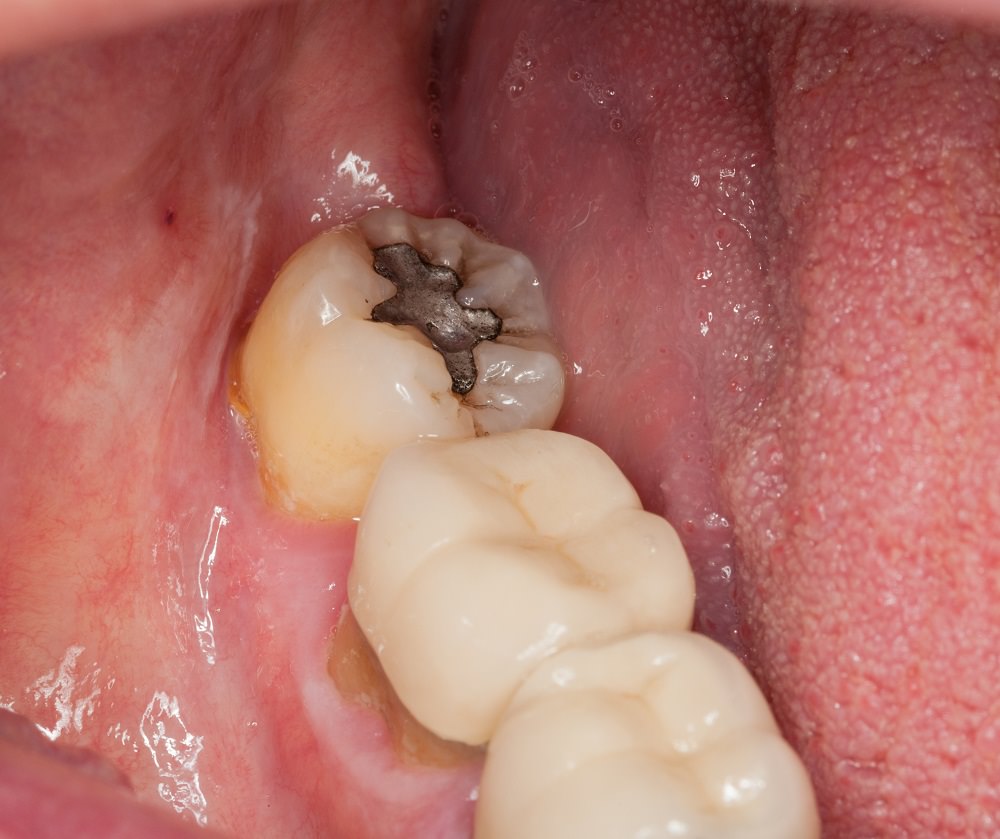
What a Silver Amalgam Filling looks like
However, the drawbacks of amalgam are a worry.
There are 4 important points we need to mention.
Disadvantages Include
- Noticeable when you open your mouth, being silver in colour, to begin with, and darkening over time.
- Inclined to expand and shrink, which may lead to a crack in your tooth.
- May let food and bacteria in, causing tooth decay.
- That though the mercury is only a small amount, and has been approved by the ADA, it’s a toxic material you might not want in your body.
Composite
A tooth filling that is made of composite (a synthetic resin such as powdered glass and acrylic resin), has become immensely popular.
They are a ‘go-to’ option for many people.
Advantages Include
- Can be matched to the colour of your existing teeth, so it is less easily seen.
- Is biocompatible, thus more versatile.
- Generally looked at as an affordable filling option.
Disadvantages Include
- The material is less long-lasting, and they will typically need to be replaced every five to seven years.
- Some do contain the chemical BPA which has been added to improve the flexibility of the plastic.
- Though used in tiny amounts and approved by the ADA, BPA may impact your hormone production.
- They take longer for the Dentist to place, usually requiring more skill. As such, more costly than amalgam.
Gold
A gold filling is typically custom-made in a laboratory.
Advantages Include
- It contains 75% gold.
- Extremely sustainable.
- Generally lasting ten to fifteen years.
Disadvantages Include
- You’ll have to spend longer at the Dentist.
- Understandably, the most expensive material.
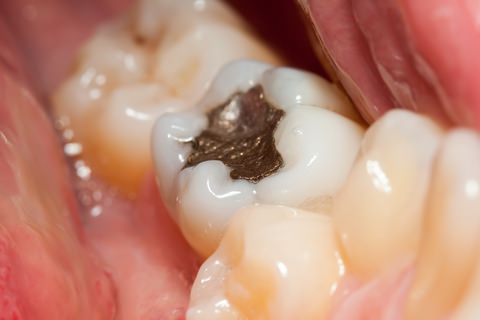
Gold is a very expensive option when considering a filling
Porcelain
Porcelain fillings are similar in many ways to gold.
They are made in a lab, so you will need to take more than one trip to the Dentist.
They are also quite costly.
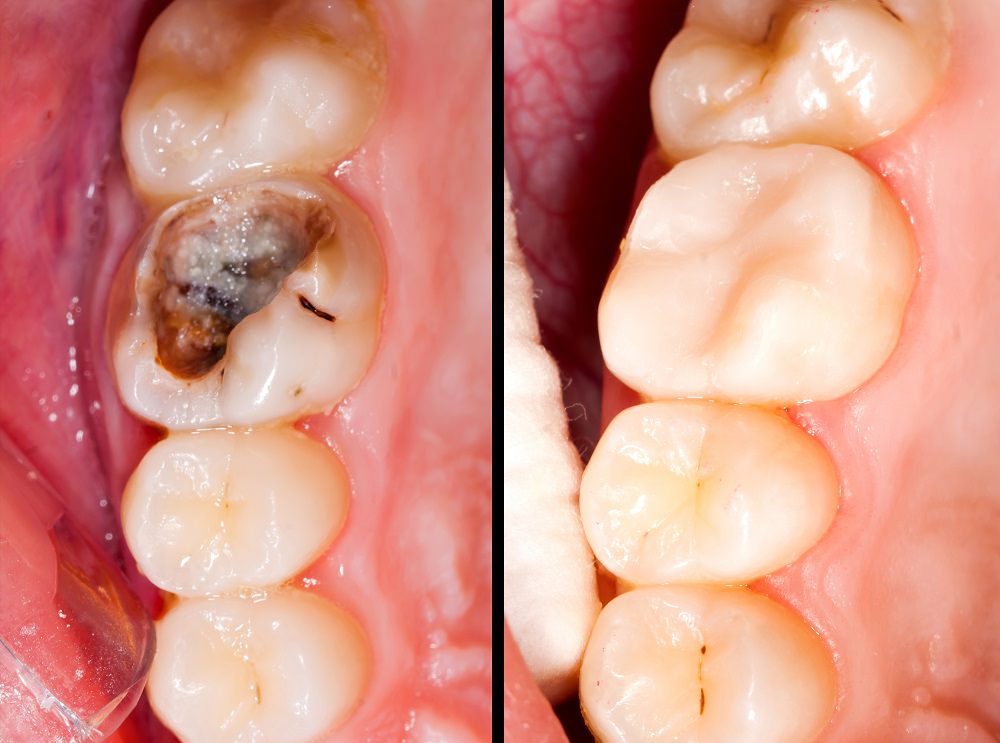
A Porcelain dental filling – Before and After
However, they are flimsier than gold.
But, the benefits of porcelain over gold are that it can be matched to the colour of your existing teeth.
This offers a natural appearance, so is a popular choice.
They are also resistant to staining.
Resin or Glass Ionomer
This material is for use on a child’s teeth only – even baby teeth – as kids get cavities as well.
It is frequently used on their primary teeth, as it can handle a substantial amount of pressure and chewing.
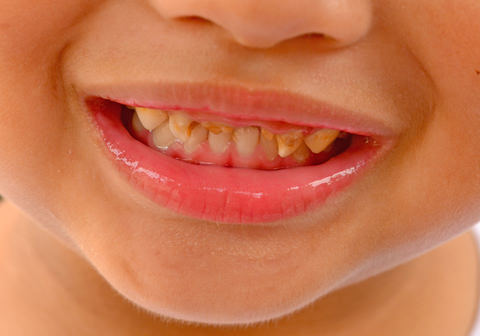
Dental caries or decay can develop in kids teeth
What Are the Alternatives for a Tooth Filling
Dental fillings are a very old-school approach to fixing your cavities.
Whilst common and effective, those that are not natural looking in colour may not appeal to you.
Well, rest easy. If you have received the news that your tooth decay has led to cavities, there is an alternative – Inlays and Onlays.
This will restore your smile in a natural-looking way that you may find more aesthetically pleasing, so you feel self-confident with your smile.
Inlays and Onlays are basically considered;
- Another type of filling, but they work well for a tooth that is too damaged for a filling but does not yet require a crown.
- Made in a laboratory, they will require two visits to the Dentist.
At the first visit, your Dentist will;
- Remove all your tooth decay.
- Make an impression of your teeth, and
- Place a temporary filling to protect your teeth until you revisit.
Between your first and second visit, technicians at the dental lab will use the impression to create an Inlay or Onlay from either porcelain or composite resin.
Then, you will revisit the Dentist, where they will;
- Remove your temporary filling.
- Cement the custom-made Inlay/Onlay onto your tooth, where it seamlessly blends with your surrounding teeth.
The difference between Inlays and Onlays is the type of decay they treat.
Inlays are put on between the bumps on the surface of your teeth, so treat the biting surface within the tooths cusps (the anatomy on top of the back teeth).
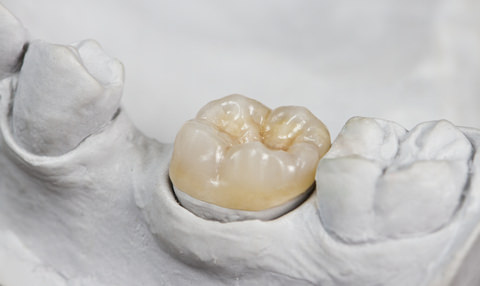
A Dental Onlay ready to be placed on a tooth.
Onlays are more complex – they might extend over multiple bumps on the surface of the tooth, therefore treating damage that is further than the cusps.
Onlays are also known as partial crowns.
The advantages of Inlays and Onlays include that they;
- Match the colour of your existing teeth.
- Will not discolour your nearby tooth (as an amalgam filling may).
- Do not require removal of much of the damaged tooth, thus preserving the tooths’ structure and strength.
- Are more durable than fillings.
- Can be used to replace a filling that you are unhappy with.
Does Medicare Cover Basic Tooth Fillings
The Australian Government does not cover the cost for most dental treatments – generally, patients must pay for their own dental work.
The only exception is Medicare will pay for what they consider necessary dental services for children and eligible adults.
The Child Dental Benefits Schedule will pay $1000 over 2 calendar years for children between 2 – 17 years old, for general dental services, including fillings.
To find out if your child is entitled, view the Department of Human Services website.
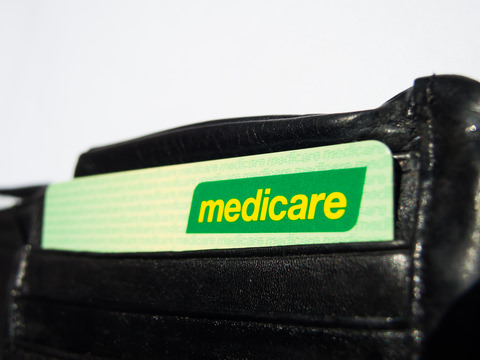
Some dental services for children and eligible adults are available through Medicare
Public dental services are also available for both children and adults.
Both basic and emergency services are accessible, though you may have to wait over a year to see a Dentist.
Typically, adults must have a Health Care Card or Pensioner Card – though this depends upon your location.
To find out what you might be eligible for, view the health department’s website for your location;
Will Private Insurance Cover Fillings, and How Many a Year?
Most private insurance plans cover some of the cost of fillings (generally about half), and you must pay the difference.
The policies vary widely between health funds – as will the difference between what they will cover, and how many you can claim each financial year.
So, there may be a limit on how many you can claim.
Others may classify them as routine dental, and thus they may be “unlimited”, meaning you can claim as many as you want.
It is important to check what is included in your insurance. You can find this under the “Extras” section of your policy.
Conclusion
If you have cavities in your teeth, your dentist may have recommended that you get fillings.
The cost of these can vary between $115 to $310, depending on both your location and the material you choose.
There are many more types of materials that can be used for a tooth filling these days.
All have their benefits and downfalls, and your Dentist will help you choose the type of material.
However, the materials available to you are;
- Silver Amalgam.
- Composite.
- Gold.
- Porcelain.
- Resin or Glass Ionomer (for children’s’ teeth only).
Dental filling and drilling is a very old-fashioned idea, so there are alternatives for your cavities – Inlays and Onlays.
You may find these a more aesthetically pleasing approach, as they are more natural-looking (they will match the colour of your existing teeth).
Other benefits include;
- Will not tarnish your surrounding tooth.
- Do not require removal of much of the decayed tooth.
- Are more long-lasting than fillings.
- Can replace a filling that you do not like.
For more information, we have a blog post on Dental Fillings and Your Options
If you had to choose a dental filling material, what would it be?
Disclaimer
Information found within this post has been sourced and referenced by professionals and is intended for informational and educational purposes only. We do not know your individual circumstance and therefore do not accept any responsibility for any errors or omissions that may occur. It is advisable and recommended to seek direct advice and consultation with either your dentist or your general practitioner.
By Anthony Cade
Created at October 06, 2020, Updated at January 25, 2025
Sorry, the comment form is closed at this time.


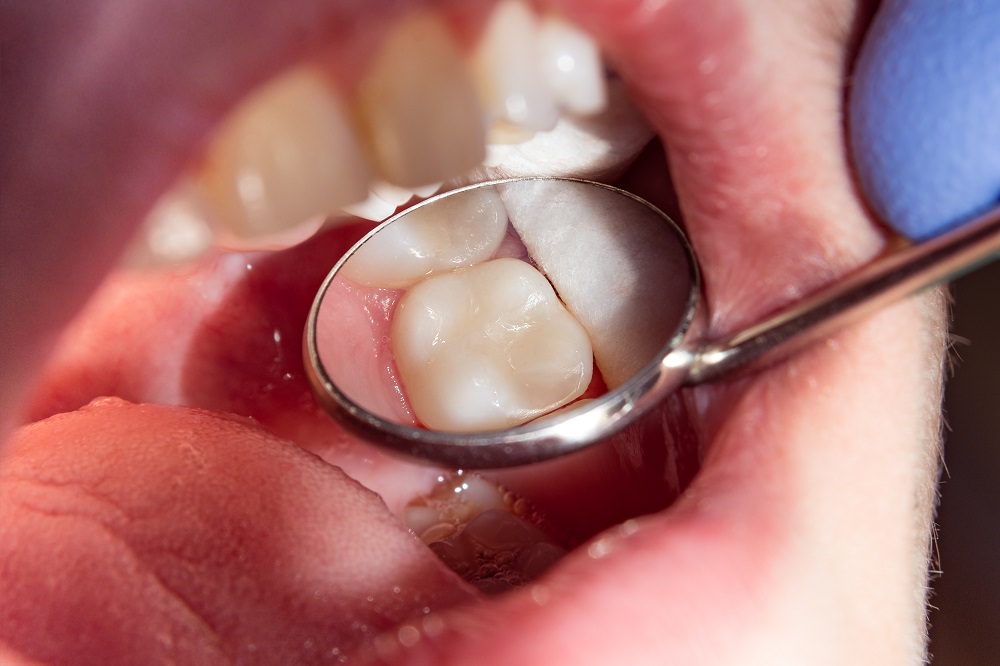
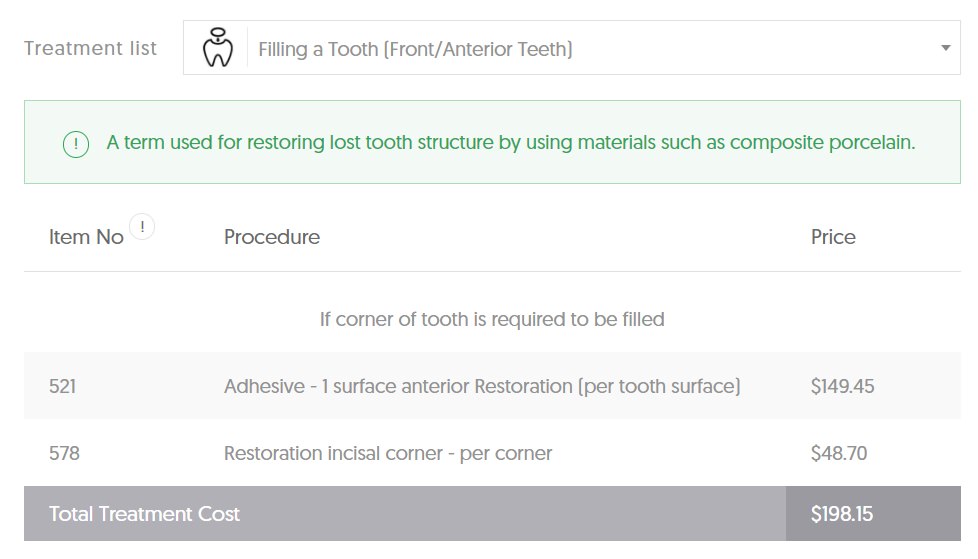
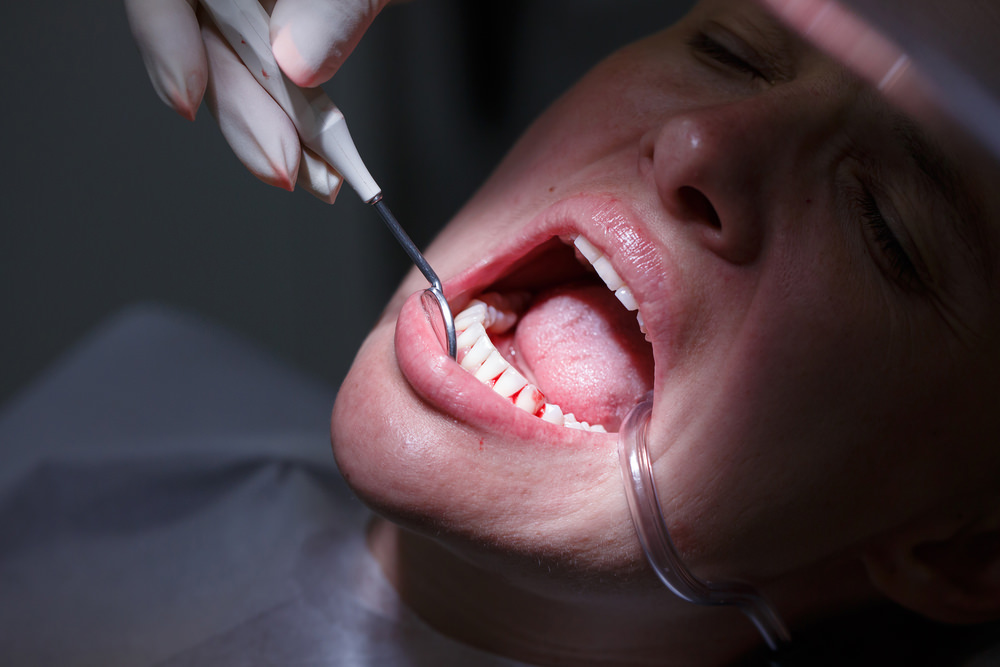

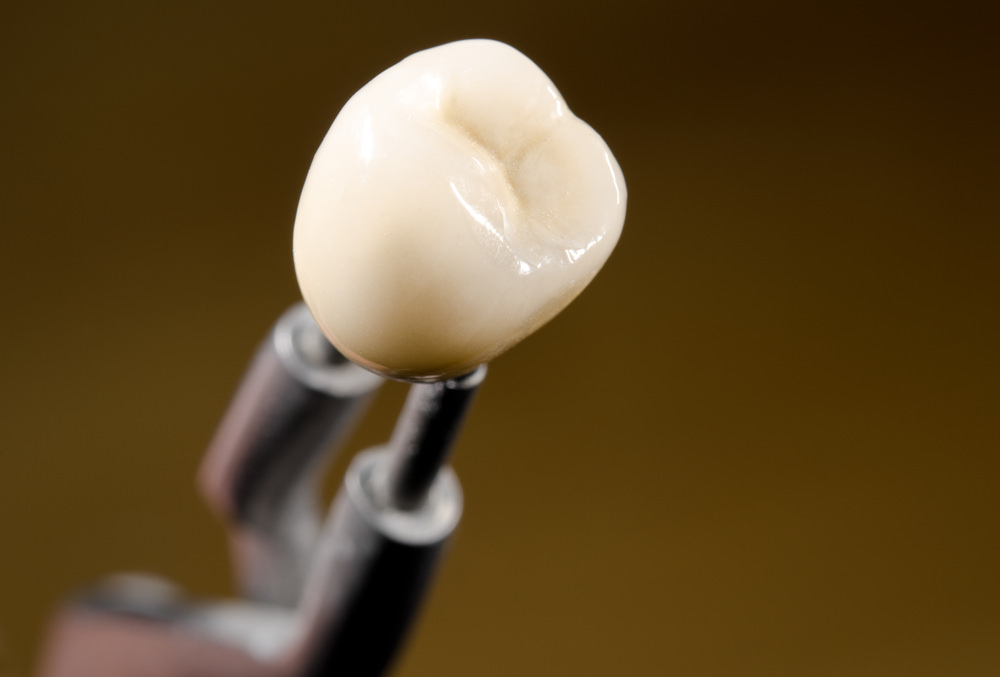
Danny Korinek4 years ago
I have existing filling on a tooth. Small decay is on the other side, will the new filling attach itself well to the existing fillin?
Thank you, regards Danny.
Andrew Adams4 years ago
Hi Danny, thanks for your comment and for reaching out to us. Please see Dr V’s response:
The decay has to be removed….so that dentist will continue drilling until the tooth is hard
ie decay is soft and we can feel the softness and continue working until we feel hard tissue…if the
new filling is going to contact the old we sometimes put a “dovetail join” just like a carpenter does with wood.
we can join old fillings to new ones.
However, if your filling is a white composite this will bond to the new composite.
The problem happens when the fillings are of differing materials and we have to figure out a way of
either bonding (gluing) the fillings together or finding a physical way of joining them.
If you ask the dentist to take a photo before and a photo after then the dentist is able to
explain the join and the way they can make sure that the tooth is restored to the best way possible.
Dr V